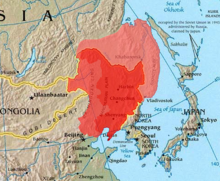Outer Manchuria
The Outer Manchuria is a region in Russian Far East , which was originally in Imperial China to the entire Manchuria and settlement area of the Manchus belonged. The Amur and Ussuri separate Outer Manchuria from Inner Manchuria in the south. In the north it borders the Stanowoy Mountains , in the east the Pacific Ocean .
history

At the beginning of the Russian conquest of Siberia , Cossacks reached the east coast of Asia via the Lena Basin and founded Okhotsk there in 1647 . When trying to extend their control to the south and to win as arable field, came the Russian settlers into conflict with the Manchu, the 1644 Qing Dynasty rule over China had won and thus were at the height of their power.
In the Treaty of Nerchinsk in 1689, the border between Russia and Manchuria was defined - albeit not very precisely - as the mountains that bounded the catchment area of the Amur to the north. Russia renounced the Albasin base on the Amur, which had recently been established . It was not until 1727 that the boundary was defined more precisely in the Treaty of Kjachta .
The decline of the Qing dynasty took place from the middle of the 19th century: European colonial powers and finally Japan tried to gain colonies and zones of influence. In the Treaty of Aigun in 1858, Russia forced all areas north of the Amur from China . In the international Beijing Convention in 1860, after the Chinese defeat in the Second Opium War against the British Empire , Russia also received the coastal area from the northeastern part of the Chinese province of Jilin, east of Ussuri, and the northern part of the Chinese province of Heilongjiang , located on the lower Amur . In the same year Alexander II had the Russian naval base Vladivostok founded in the south of the newly acquired area .
present
In the present administrative structure of the Russian Federation , the Outer Manchuria is divided
- the Amur Oblast (864,458 inhabitants) on the upper and middle Amur
- the Jewish Autonomous Oblast (186,541 inhabitants) around Birobidzhan
- the Primorye region (2,019,529 inhabitants) around Vladivostok
- the southern half of the Khabarovsk region (1,412,260 inhabitants, most of them in the Amur Valley)
In addition to Russian, Manchurian is occasionally spoken. These include 12,160 nanai , of which 10,993 live in the Khabarovsk region. There are also 2,804 Ultschen , also in the Khabarovsk region, and Udegen (Primorye and Khabarovsk regions). The largest East Asian population in the region is 27,418 Koreans .
In order to revive the sparsely populated region, the Russian government has been giving away land in the Amur region since 2016. Every Russian can choose a free plot of land on the Internet . Areas on major roads or near cities are blocked. The authorities demand that the new owners use the land they received economically. The supply has so far met with weak demand. In general, the cost of living in Outer Manchuria is high as all goods have to be brought from far away. The standard of living is correspondingly low . According to a survey from 2016, 45 percent of residents would like to leave the Amur area.
See also
literature
- Wolfgang Seuberlich: On the administrative history of Manchuria (1644-1930). Otto Harrassowitz Verlag, 2001.
- Paul Ulrich Innocence : China's Trauma. China's strength. The decline and rise of the Middle Kingdom. Springer-Verlag, 2016.
Individual evidence
- ↑ Nationality statistics of the Russian census of 2002 ( MS Excel ; 203 kB; English)
- ↑ Free properties in the Far East Deutschlandfunk (September 3, 2016), accessed on October 8, 2017
